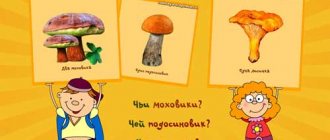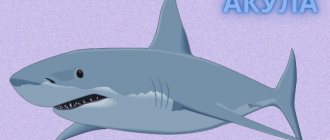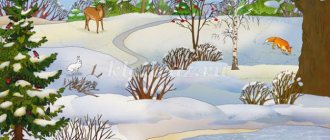Project “Earth is our common home” preparatory group
Transcript
1 -Municipal state-owned preschool educational institution - kindergarten 6 in Tatarsk Project “Earth is our common home” preparatory group Author of the project: Adamsonova Natalya Nikolaevna teacher of the 1st qualification category 2022
2 Project passport. Project characteristics: Priority educational area: cognitive development, speech development, social and communicative development, physical development, artistic and aesthetic development. by subject area: integrated; by the nature of children's dominant activity: cognitive research; creative by number of participants: group; by duration of implementation: long-term by the nature of project coordination: direct. Relevance: one of the fundamental tasks in environmental education of preschool children is the task of developing an environmental culture. The ecological culture of a preschooler implies the following competencies: an emotionally positive attitude towards nature and the surrounding world; responsible attitude towards your health and the environment; compliance with moral norms and rules in the system of value orientations of an environmental nature. In the process of observing the children of the preparatory group, it turned out that the children had superficial knowledge about nature, its protection, behavior in nature and why all living organisms should live on Earth. Gaps in children's ecological culture arise. Thus, the need arose to develop the project: “The Earth is our common home.” Project goal: Development of children's environmental culture based on emotional experiences and practical actions. Deepening children's environmental knowledge, instilling in them a humane attitude towards nature, a sense of responsibility for all life on Earth. Objectives: 1. to form children's ideas about the need to take care of the surrounding nature, plants, animals, and bodies of water; 2. expand children’s knowledge about the life of plants, their needs, and how to care for them; 3.develop curiosity, communication, and a value-based attitude towards the natural world; 2
3 4.develop children’s productive activities and creative abilities; 5. to cultivate friendly relationships between children in the process of games and joint activities. Conditions for the implementation of the project: 1. Interest of children and parents, teachers and kindergarten workers. 2. Regularity and systematicity. 3. Implementation of the project through all types of children's activities. Integrated interaction: Expected results of the project: 1. A sense of empathy is formed, children become kinder, good feelings for nature arise, knowledge about the need to preserve and increase the wealth of the native planet Earth is deepened. 2. There is a desire to competently protect nature and fight for its conservation. 3. Design of an exhibition of drawings by children and parents on the theme “The earth is our common home!” Project stages: 1. Motivational; 2. problem-based and activity-based; 3. creative; 3
4 1. Motivational stage: 1. Development and accumulation of methodological materials on the problem. 2. Discussion of problematic issues and ways to solve them. 3. Creation of the necessary conditions for the implementation of the project (preparation of materials and equipment). 4. Questioning parents on the problem. 5. Long-term project planning. Creating conditions for independent activity: 1. Didactic games: “Who knows more countries?”, “What grows where?”, “Who lives where?”, “Earth and solar system”, “Trees”, “Man”, “ Insects", "When does this happen?" 2. Printed board games: “Zoological Lotto”, “Whose House?”, “Wild Animals” 3. Folders for viewing and discussion: “The Earth is our cosmic home”, “The Earth is our common home” “Man and Nature” » 4. Books and albums for children to look at: “The Red Book”, “I Want to Know Everything”, “Playing Science”, “The Living World”, “Tales of Nature”, “What is Space?” 5. Role-playing games “Space Explorers”, “Nature Defenders”, “Sea Pathfinders”, “Streets of Our City” 6. Outdoor games: “Trees and Worms”, “Hunters and Animals”, “Run to the Named Tree”, “Sun and Rain”, “Coast, Sea, Sails” 7. Watching the cartoon “Spasik and His Friends”, visiting the planetarium “Do you want to go to space?” 8. Labor: work in the garden, in a corner of nature - watering, loosening, caring for fish, turtle. Interaction with parents to involve them in the educational process: - survey of parents: “What is ecology?”; -parent meeting “Participation of adults in the lives of children” - thematic consultations “What is the richness of the earth”” “The earth is our common home” - folders on the topic of education: “Moral and environmental education of preschool children”, “Earth is our cosmic home" - individual conversations. — design of the stand “The Earth is our common home” 4
5 Questionnaire. The purpose of the survey: to identify the attitude of parents to the issues of environmental education of preschoolers in kindergarten and its actual implementation in the family. 1. What is ecology? 2. Do you have indoor plants? If not, why not? 3. Does the family have a dog, cat or other animals? 4. Have you planted a tree? 5. Have you ever made bird feeders? 6. Do you read books about nature to your child? 7. Do you often go to the forest with your child, does he like it there? 8. Do you tell your child about the benefits of trees, medicinal herbs, berries, insects, etc.? 9. Does your child show a caring attitude towards animals and plants? 10. How do you feel about introducing a child to nature in kindergarten? 11. Your suggestions for organizing environmental education in kindergarten. Results of the parent survey: parents actively took part in the survey and answered all questions. The answers led to the fact that parents do not pay enough attention to the environmental education of their children. Stage 2: Problem-based and activity-based The second stage took place in the process of implementing all educational areas: social and communicative development, cognitive development, speech development, physical development and artistic and aesthetic development. 5
6 To solve the problems of the project, I used the following forms of interaction between the teacher and children: Educational areas Social and communicative development Forms of implementation Games and play exercises that promote the development of a positive attitude towards nature: 1 “What can one do” 2. “I rejoice in the sun, rain, snow and wind » 3 “I don’t trample grass, I don’t break trees, I don’t scatter garbage, I don’t scatter garbage, I don’t offend animals” 4. Didactic game “Find a home for an animal.” Goal: to develop interest in the inhabitants of different natural zones 5. “Help another.” Goal: to develop a sense of collectivism, mutual assistance, and goodwill in the game. 6. “I want to show you.” Goal: continue to develop the ability to interact with play partners. 7. Game exercise: “Droplets go around in a circle.” 8. “What am I experiencing?” Purpose: to teach how to identify and convey an emotional state through facial expressions when listening to literary works. 9. Communicative game “Earth is the planet on which we live” 10. Card index of communicative games for the preparatory group 11. Role-playing games: “Zoo”, “Space Explorers”, “Nature Defenders”, “Sea Rangers”, 12. Security : d/i “Green Planet” 6
7 13. GCD 1. Topic: “The Earth is our common home” 2. Topic: “Ecological KVN “In Union with Nature” Cognitive development 14. Ethical conversations: “The Earth is our common home”, “In the natural world”. 15. Partial program “Young Ecologist” p. N. Nikolaeva 1.Game situations. The teacher offers situations that develop in preschoolers the ability to structure their behavior and activities in accordance with the norms and rules of behavior in nature. For example: cultural behavior in nature; we are friends and helpers of nature; children's feelings of empathy towards nature 1. Problem situations. Children not only discuss the problem, but also solve it together with the teacher. Such situations awaken children’s initiative, independence, responsiveness, and willingness to look for the right solution. Preschoolers learn models of social relationships, namely practical help, active attention, caring for animals, birds, fish, insects. For example: “What will happen to our planet if.” how to help a sick kitten; let's help the plant; how to help a girl who is lost in the forest" 2. Educational games: "Earth and the solar system", "What, where, when?" 3. Research activity: “Experimentation “Wood, its qualities and properties” 4. Purpose: to teach to recognize objects made of wood, to determine its quality (hardness, surface structure, thickness, degree of strength) and properties Printed board games: “Loto animals", 7
8 “Who lives in the house?” 5. Watching the cartoon: “Spasik and his friends” Construction of “Bridges”, “Birdhouses” Speech development Physical development 1. Illustrative situations. With the help of various gaming materials and teaching aids, the teacher demonstrates to children examples of socially acceptable behavior, and also activates their effective communication skills: pictures and environmental plot pictures with rules of behavior in nature on moral and ethical topics: “characters of a tabletop or finger theater, with the help of which Situations are played out where the child needs to understand the current situation. 2. Situations addressed to the child’s personal experience. It is very important that the content of the situation coincides with the experience of the children, their life impressions: we plant a vegetable garden on the windowsill; preparing manuals for classes (cutting, gluing, etc.) 3. Reading the poem by V. Orlov “A house under a blue roof.”, l. Kvitko “On the sand”, vol. Shorygina “The Wizard from Planet Omega” 2.D/game “Find a house for the animal” 4. Memorizing the poem “Our Planet Earth” 5. Storytelling based on the picture “My Blue Planet Earth”, Games with running: “Trap” “Trap, take it” tape! “Pair running” “The third wheel” “We are funny guys” “Make a figure” “Sly fox” “Homeless hare” Games with jumping: 8
9 Artistic and aesthetic development “Fishing rod” “Classes” Games with crawling, crawling, climbing: “Bears and bees” “Firemen in training” “Migration of birds” Folk games: “Cap” “Guess who’s calling?” Games with throwing and catching: “Hit the hoop” “Knock down the pin” Relay races: “Relay in pairs” “Carry the ball without hitting the pin” “Fast team”. Gymnastics for the eyes: “Let’s rest”, “I will find you” 1. Creative situations: - draw a “Globe”; “Destruction of the planet”, “What is on earth” - we sculpt “Solar system” (patterned);, “Life on earth and in space”, “Who lives on the globe” - application “Sea inhabitants”, “Friendship of peoples”, “Rocket”, “Northern Lights” 2. Listening to, learning songs and dances about nature “The sun has friends”, “Summer in music” The educational situations created are focused on personal development, provide for the formation of readiness for joint activities with peers and adults, promote emotional well-being of preschoolers and a positive attitude towards the surrounding reality. In addition, preschoolers’ ideas about social reality are enriched by attending performances in preschool educational institutions. conducting excursions, observations, targeted walks; reading works of fiction. 9
10 Stage 3 creative: Results of the project “Earth is a common home”: The results of the project were the organization of interesting, meaningful, meaningful and environmental activities for children, taking into account personality development and age characteristics. During the implementation of the project, the following results were achieved: - basic environmental knowledge and a culture of behavior in nature were formed; - children began to understand the relationships in nature, began to treat animals, birds, and insects more carefully; - interest in natural phenomena and objects appeared; — strengthened the ability to experiment, analyze and draw conclusions; — the environmental culture of parents has improved, they have become more attentive to environmental issues; — the educational environment of the educational educational institution “The Earth is our common home” has been replenished. Goal: To develop environmental knowledge in children, a caring attitude towards nature and everything around them. Objectives: To form in children a caring, responsible, emotionally friendly attitude towards the natural world, towards living beings, in the process of communicating with them. To develop observation and experimentation skills in the process of search and cognitive activity. To develop children's imagination, speech, imagination, thinking, ability to analyze, compare and generalize. Cultivate friendly relationships between children during games and joint activities. Analysis, generalization and summing up of creative activities. Presentation of the project result in the form of a presentation. Applications: 1. Card index “Ecological games”, “Ecological signs” 2. Program of classes for children of senior preschool age. 10
11 3. Folders: “Moral and environmental education of preschool children”, “Man and nature”. “The Earth is our cosmic home” 4. Ethical conversations with children. 5. Abstract of the GCD “The Earth is our common home.” 6. Consultations - advice “The Earth is our common home” 11



